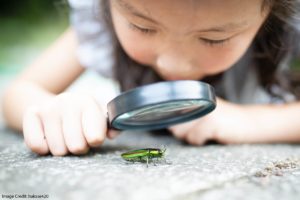As teachers, we know that learning works better when students are curious about the subject they’re studying.
Obviously.
So, what can we do to encourage curiosity?
We could choose a topic that (most) students find intrinsically interesting. Dinosaurs, anyone?
But, we can’t always work on that macro level. After all, many of us work within a set curriculum.
What strategies work on a smaller, more day-to-day level? In other words: is there anything we can do in the moment to ramp up students’ curiosity?
Before you read on, pause a moment to ask yourself that question. What do you predict might work?
Predictions, Please
According to a recent study, the very fact that I asked you to make a prediction increases your curiosity about the answer.
Researchers in Germany asked college students look at a question, such as “X out of 10 animals are insects.”
Sometimes the students made a prediction: “4 out of 10 are insects.”
Sometimes they thought about an example of an insect: “mosquitoes.”
Sure enough, students rated their curiosity higher after they made a prediction than after they provided an example.
And…drum roll please…they also remembered those facts better when their curiosity levels were elevated.
Don’t Take My Word For It
By the way: how did the researchers know how curious the students were to find the answer?
First, they asked them to rate their curiosity levels. That’s a fairly standard procedure in a study like this.
But, they also went a step further. They also measured the dilation of the students’ pupils. (You may know that our pupils dilate when we’re curious or surprised.)
And, indeed, by both measures, making predictions led to curiosity. And, curiosity led to better memory of these fact.
What To Do Next?
On the one hand, this study included relatively few students: 33, to be precise.
On the other hand, we’ve got LOTS of research pointing this direction. Some studies show that pretesting helps students learn better, even if the students can’t possibly know the answer to the question on the test.
So, some kind of early attempt to answer a question (like, say, making a prediction) does seem to help learning.
At the same time, I think it would be quite easy to overuse this technique. If students always take a pretest, they’ll quickly learn that they aren’t expected to know the answers and (reasonably enough) won’t bother to try.
If students always make predictions, I suspect they’ll quickly pick up on this trick and their curiosity will wear down.
As teachers, therefore, we should know that this approach can help from time to time. If you’ve got a list of important facts you want students to learn, you build predictions into your lesson plan.
I myself wouldn’t do it every time. But, I think it can be a useful tool–especially if you need to know how many animals are insects. (In case you’re wondering: the answer is, “7 out of 10.” Amazing!)




